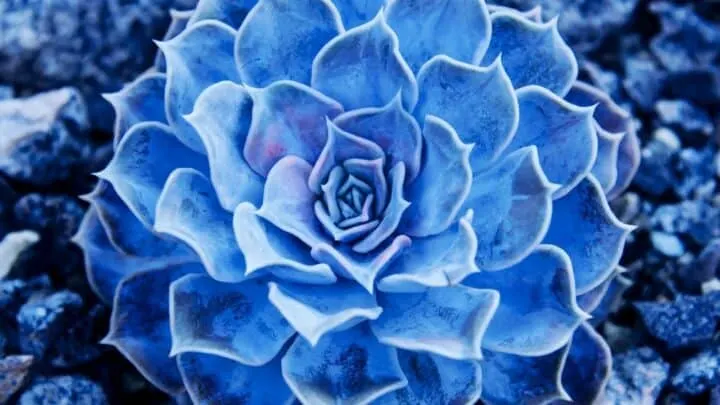In this article, I will talk about the prettiest blue succulents from my point of view.
The color of these elegant, gorgeous plants ranges from pale blue-grey to dark blue with red edges. The shapes are diverse and range from tall sword-like clusters to bunches of juicy tiny flower-like rosettes.
Table of Contents
Which are the prettiest blue succulents?
- Agave potatorum (Butterfly Agave)
- Echeveria ‘Blue Prince’
- Agave tequilana (Blue Agave)
- Sedeveria ‘Blue Borrito’
- Senecio Mandraliscae (Blue Chalksticks)
- Echeveria ‘Blue Bird’
- Sedum reflexum (Blue Spruce Stonecrop)
- Aloe ‘Blue Sky’
- Aloe ‘Blue Elf’
- Mangave ‘Tooth Fairy’
- Corpuscularia lehmannii (Ice Plant)
- Pilosocereus azureus (Blue Torch Cactus)
1. Agave potatorum ‘Butterfly Agave’
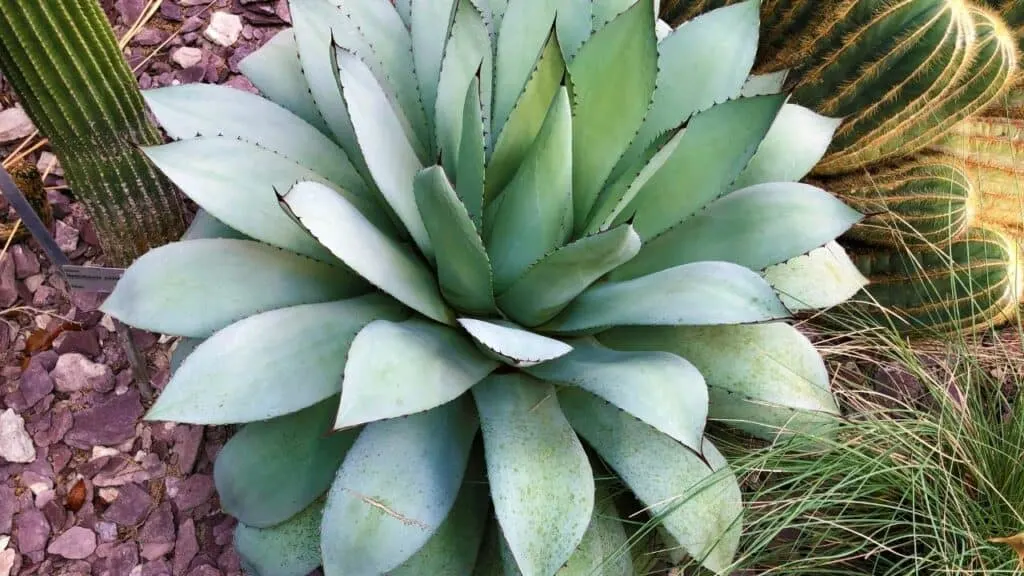
Agave potatorum, better known as Butterfly Agave, is an elegant succulent native to the Mexican highlands. Beautiful, wide, grey-blue 18-inch long leaves form a dense rosette that can reach two feet in height and three feet in diameter.
This agave blooms when mature in summer and develops a flower stalk that can reach 20 feet. It is topped with pale green and yellow flowers with red edges. After blooming, the plant dies, and its life cycle continues through its offsets that can be repotted in its pot.
Because of its fairly small size for agave, Butterfly Agave is perfect for a nice sunny spot at home, as long as you can provide it with about six hours of sun and bright light.
Water your agave only when the soil is dry. Plant in nutrient-poor, free-draining coarse soil and do not bother with fertilizing.
This agave grows slowly and will provide a wonderful focal point in your home without outgrowing its spot too soon. It thrives on a bit of neglect and does not like to be disturbed, which works very fine if you do not like to fuss over your plant treasures.
This agave has irritating sap and sharp spines, so handle with care!
2. Echeveria ‘Blue Prince’

Echeveria ‘Blue Prince’ is a magnificent Mexican native with flower-like dark blue leaves edged in red. The thick leaves form a dense rosette and are coated with a fine powdery residue. When grown in full sun, this echeveria maintains its compact, dense look and intense dark blue color.
Echeveria “Blue Prince” blooms from spring to summer, producing lovely tulip-shaped pink to red flower clusters on a tall, thick stalk.
Echeveria thrives in bright sunlight, so a window with southern exposure is the best spot. Place your plant under the grow light or fluorescent lamp if you lack natural light.
It needs well-draining soil and very little water. Ensure the pot has a large draining hole to drain the excess water. You can keep your echeveria outdoors in summer, but bring it indoors before the first frost.
Echeveria produces plenty of offsets or “chicks” around the mother plant. If you let them grow in the same pot, they resemble a chicken with a bunch of chicks, earning this plant the nickname “Mexican Hens and Chicks.”
Hens and Chicks are safe for cats and dogs.
Once big enough, offsets can be cut off the mother plant and planted in their pots.
3. Agave tequilana ‘Blue Agave’
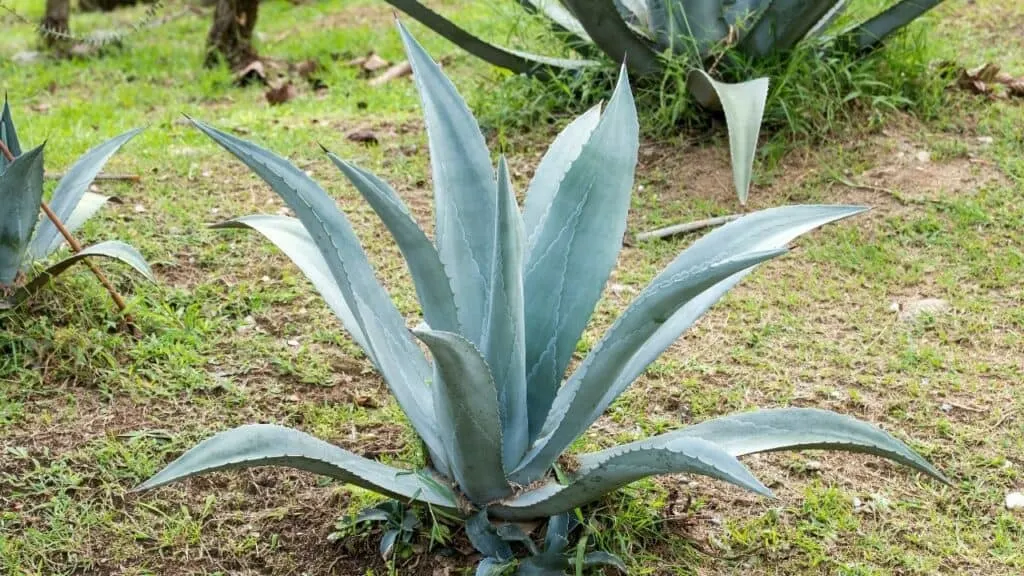
Probably best known of all blue succulents, Agave tequilana “Blue Agave” is a spectacular evergreen succulent native to Mexico. Its four-foot long lance-shaped leaves are blue-grey and have a brown central spine and sharp small spines at the edge of the leaves. The leaves form a six-foot-tall rosette.
This agave matures in five to eight years, producing a 20-foot-tall flower stalk topped with 20 to 25 branches with green flowers and purple stamens. Once the plant finishes blooming, it dies.
This agave needs full sun and a high temperature that should never go below freezing. It needs very little water, so plant it in well-draining, poor soil with plenty of coarse matter.
Agave produces plenty of offsets that can be used to propagate the mother plant. Pick those with well-established roots and twist them off the mother plant when they are a few inches tall.
The sap of this agave irritates the skin, so be careful when repotting. Blue agave is used for producing tequila in Mexico.
4. Sedeveria ‘Blue Burrito’
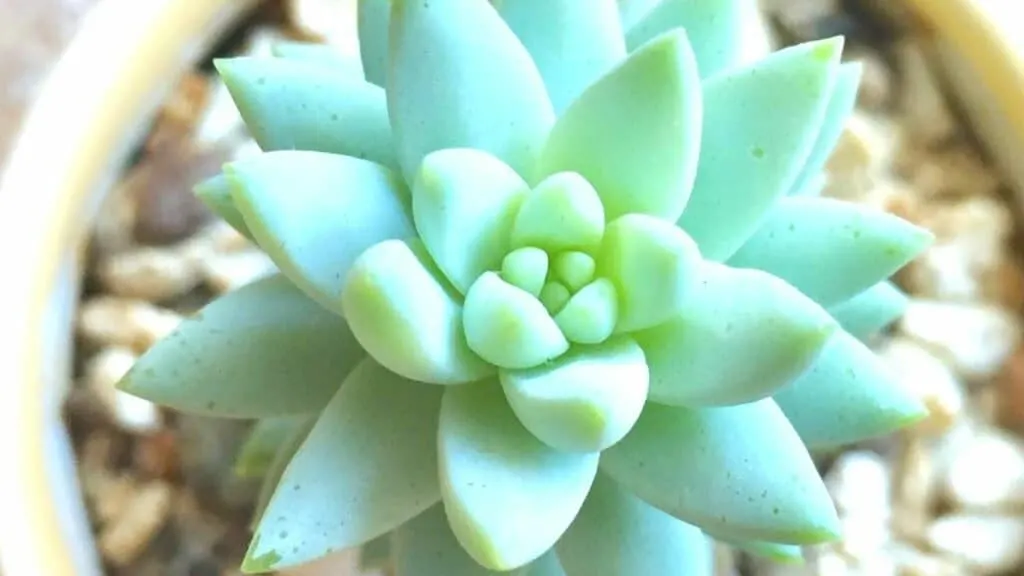
Sedeveria “Blue Burrito” is an adorable hybrid succulent created by crossing Sedum morganianum and Echeveria peacockii. It has juicy blue-green leaves with pink tips that grow in a rosette. The rosette can reach six inches in diameter. Each rosette grows on long and trailing stems that can reach 12 inches. Usually, pots grow a clump of Sedeveria rosettes.
Sedeveria “Blue Burrito” needs well-draining, nutrient-poor soil with plenty of coarse matter. It does very well indoors if you can provide six hours of full sun and bright light. Water very little, and do not bother with fertilizing. This plant is also known as Stonecrop since only stones can grow as easily.
Sedeveria is propagated easily by stem cuttings. Just cut them off the mother plant and stick them in the pot.
5. Senecio Mandraliscae ‘ Blue Chalksticks’
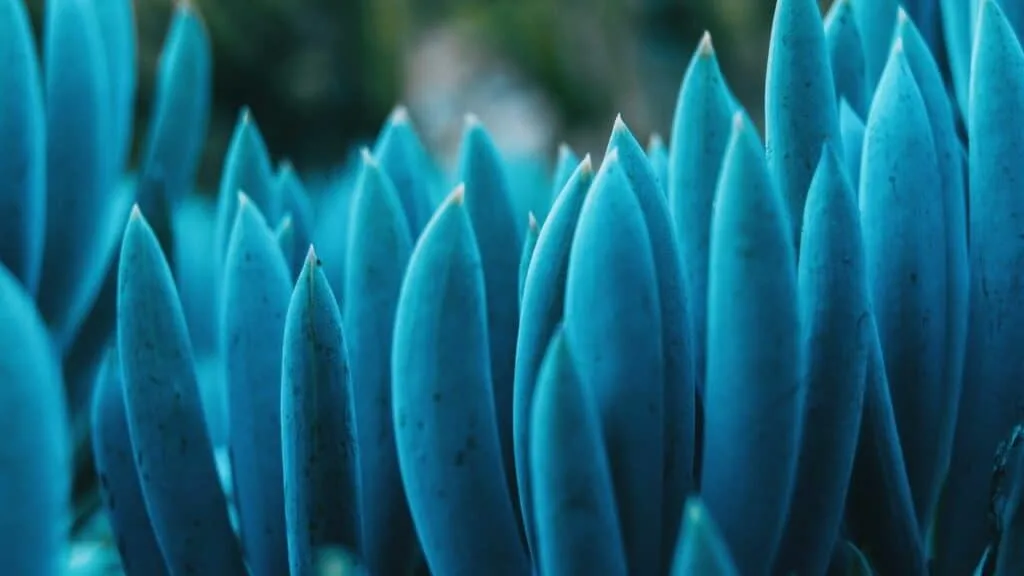
Blue Chalksticks, also known as Blue Fingers, is an interesting succulent native to South Africa, where it grows in crevices between rocks. The leaves are bright blue and look like little fingers that can grow up to 18 inches. They are covered in a fine powdery coating called farina.
Blue Chalkstick blooms in mid-summer, producing tiny white flowers. They attract hummingbirds, bees, and butterflies, so if you are growing it indoors, place your Blue Chalkstick on the windowsill where it can get full sun for five to six hours.
This plant needs very little water and can go without water for a long time. Plant it in well-draining soil that does not retain water. Cactus or succulent commercial soil mix works well. Water only when the soil is dry.
This plant spreads with underground roots and forms a ground cover when planted in the garden. It can be easily reproduced by cutting new plants once they pop up and planting them in the new pot.
6. Echeveria ‘Blue Bird’
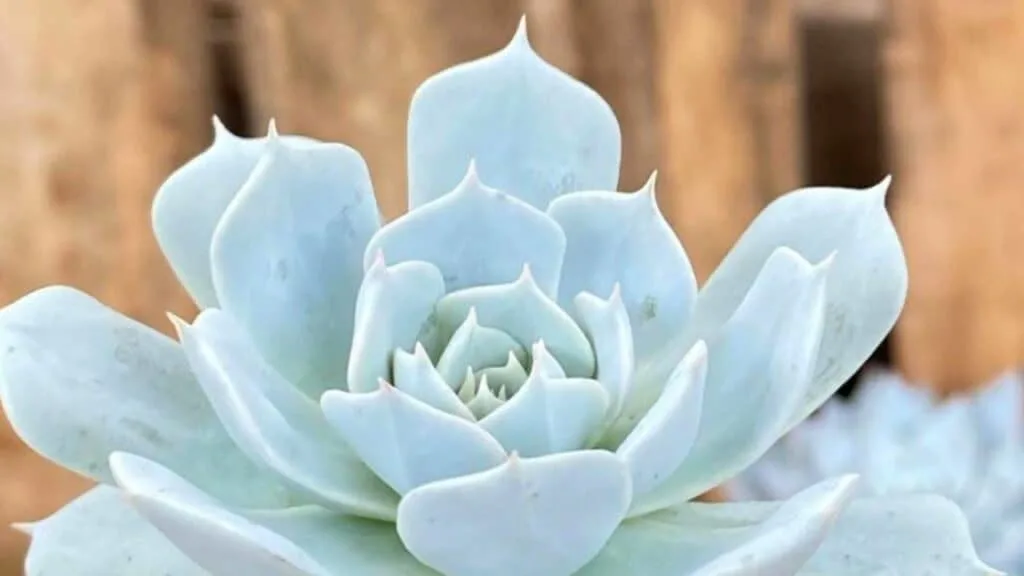
Echeveria “Blue Bird” is a lovely, delicate-looking succulent with small blue rosettes that look like flowers. They can form lovely small blue clumps if the offsets grow in the same pot. If you leave just one rosette in the pot, it will grow up to ten inches in diameter. Leaves are covered in a fine powdery coating called farina, making leaves look like velvet.
This plant loves full sun but will take partial shade. It needs plenty of bright or a grow light when grown indoors. Water only when the soil is dry. Don’t bother with fertilizing. Ensure you do not overwater your plant by planting it in well-draining, nutrient-poor soil that does not retain water.
Echeveria “Blue Bird” is easy to propagate – just cut the new offsets and plant them in their pot.
7. Stonecrop ‘Blue Spruce’
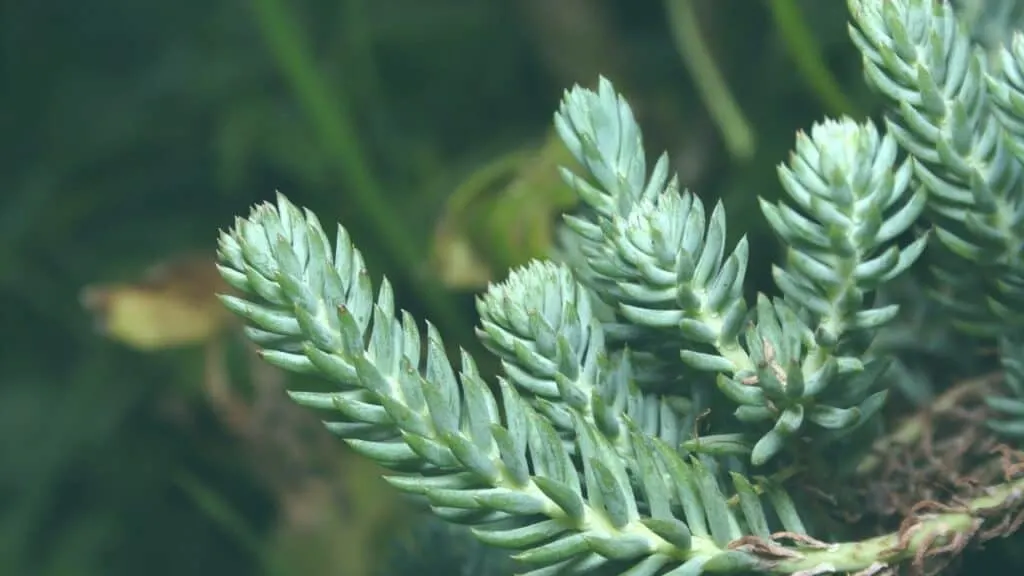
Stonecrop or Sedum reflexum “Blue Spruce” is an unusual evergreen perennial growing low and forming mats of blue-green needle-like leaves. The leaves grow on stems that make them look like spruce needles. In the summer, these lovely succulent blooms produce vivid yellow flowers that look like little stars.
Very easy to grow and demanding little care, this sedum requires little water, bright light, and full sun. If grown in the garden, it will make a wonderful ground cover. In a pot indoors, it needs a sunny spot near the window with southern exposure, free-draining soil, and very little nutrients. A larger pot, combined with larger, taller succulents, makes a spectacular arrangement of succulents.
8. Aloe ‘Blue Sky’

Aloe “Blue Sky” is a stunning succulent with wide pale blue leaves edged by orange spikes. The leaves at the heart of the rosette are much smaller.
This aloe thrives in full sun and temperatures between 70 and 80°F (21 to 26°C). The more light it gets, the more vibrant its color gets. Try to keep your aloe near the window with southern exposure.
Water Aloe “Blue Sky” only when the soil is completely dry and thoroughly soak. Let the excess water drain before placing your aloe in its regular spot.
Aloe “Blue Sky” flowers in spring and summer, and the lovely orange blooms sometimes last until fall. They attract bees and hummingbirds, so you might want to place aloe on the balcony or deck while in bloom.
This aloe is easy to propagate using offsets once they are an inch or two tall and have a good root system. Leaf cuttings and seeds can also propagate this aloe.
9. Aloe ‘Blue Elf’
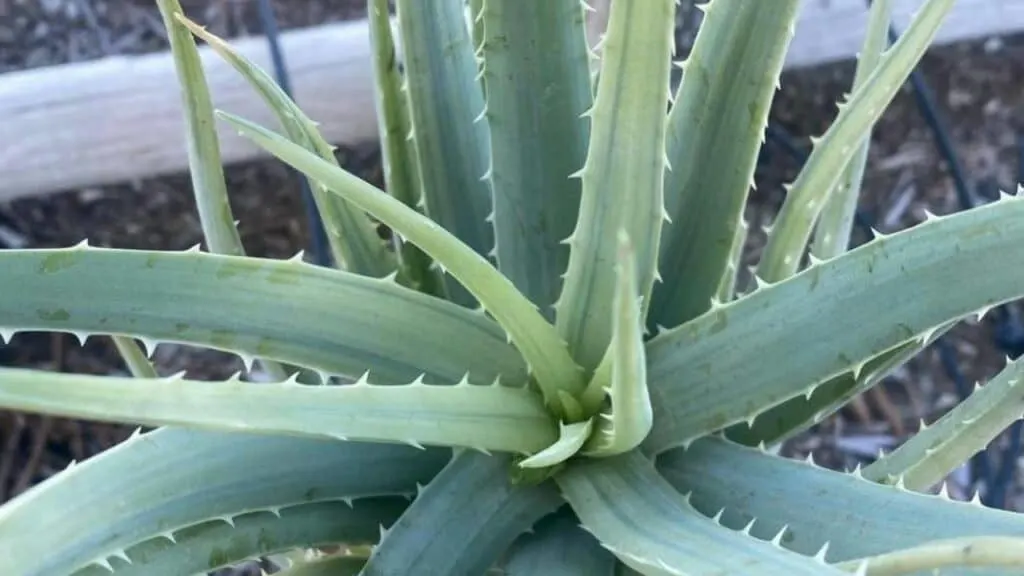
Aloe “Blue Elf” is an evergreen hybrid succulent with narrow blue-grey leaves growing upright in a dense rosette. Leaves are edged by striking orange spikes.
This aloe is tough, easy to care for, sun and heat-loving plant that works perfectly for the limited space at home as it grows upright primarily. It combines wonderfully with low-growing, spreading succulents.
In late winter and early spring, aloe “Blue Elf” develops orange stalks with lovely orange flowers. If you leave offsets in the same pot as the mother plant, you might get all of them blooming simultaneously, creating a dramatic riot of color. With good conditions, this aloe might bloom any time of the year.
Keep your aloe near the window with southern exposure, with plenty of light. If it gets enough sun, the leaves of your aloe will get a delicate red tinge.
Plant your aloe in nutrient-poor, free-draining soil. It hates when its roots sit in the water. Ensure the pot has a large drainage hole and let the excess water drain freely. Water only when the soil is dry.
10. Mangave ‘Tooth Fairy’
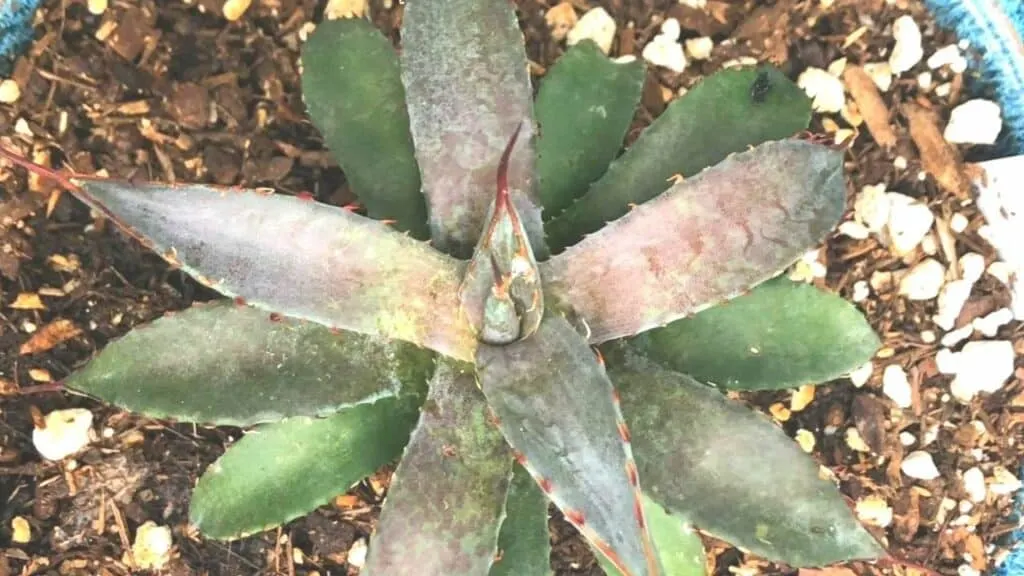
Mangave “Tooth Fairy” is an incredibly beautiful succulent with wide, triangular-shaped silver-blue leaves edged with a rainbow of prominent teeth that range from chocolate brown to bright orange. Add to that pale cranberry-colored spot on the slightly curved leaves, and you have a dramatic focal point for your blue succulent collection.
Mangave is a hybrid of agave and manfreda and it grows faster than agave but does not die after blooming. If you give it enough bright light, six hours of sun, a hot, dry environment, and free-draining soil, it might bloom every summer!
This mangave does not grow as fast indoors as in the garden, so it rarely exceeds 12 inches in height and 10 inches in diameter. It does not need frequent repotting. Every two to three years is fine, or when you see roots coming out of the drainage hole.
11. Corpuscularia lehmannii
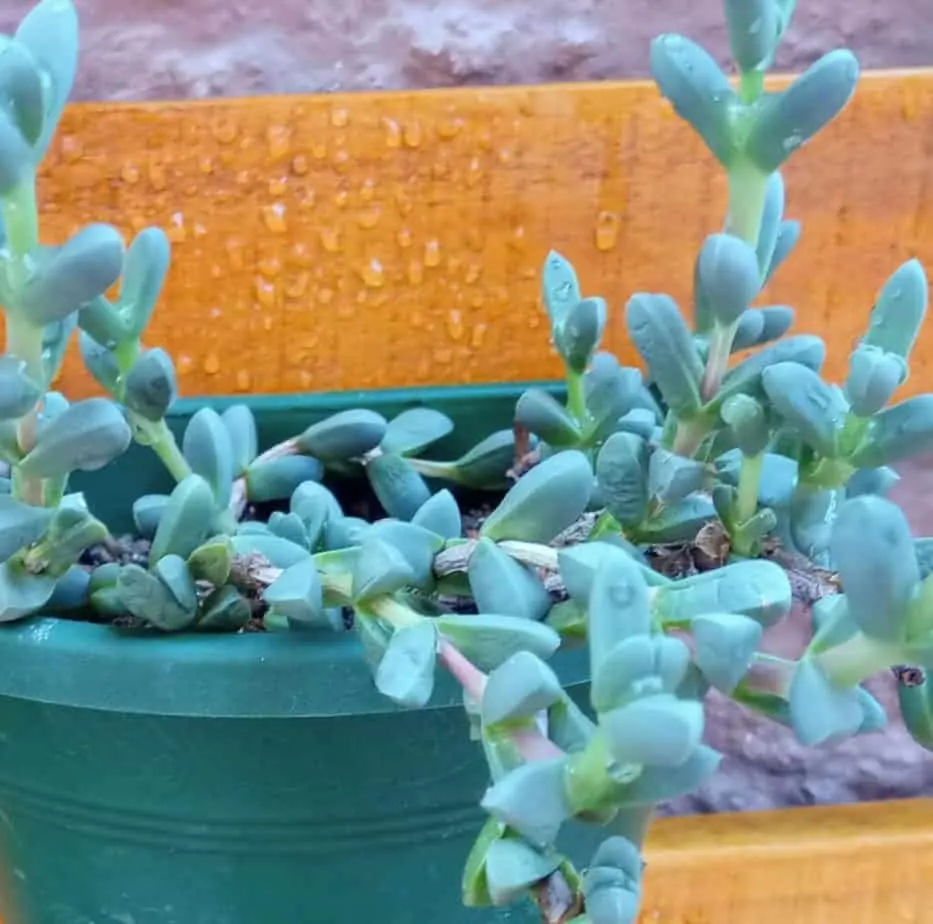
Corpuscularia lehmanii or the Ice Plant, is a strange-looking succulent with blue-green fleshy leaves in the shape of ice cubes. They have an unusual three-sided triangular shape and grow on a stalk in pairs. Ice plant grows to eight inches in height. In the summer, each branch produces a lovely daisy-shaped yellow flower.
This South African native loves a hot, dry environment and plenty of sun. Water it only when the soil is dry, and ensure all excess water drains away.
Branch cuttings can propagate ice plants. Cut three to six-inch-long cuttings from a branch. Remove all leaves except the top two. Leave the cutting to dry overnight. Plant each cutting in its pot, in the cactus or succulents soil mix.
12. Pilosocereus azureus (Blue Torch Cactus)
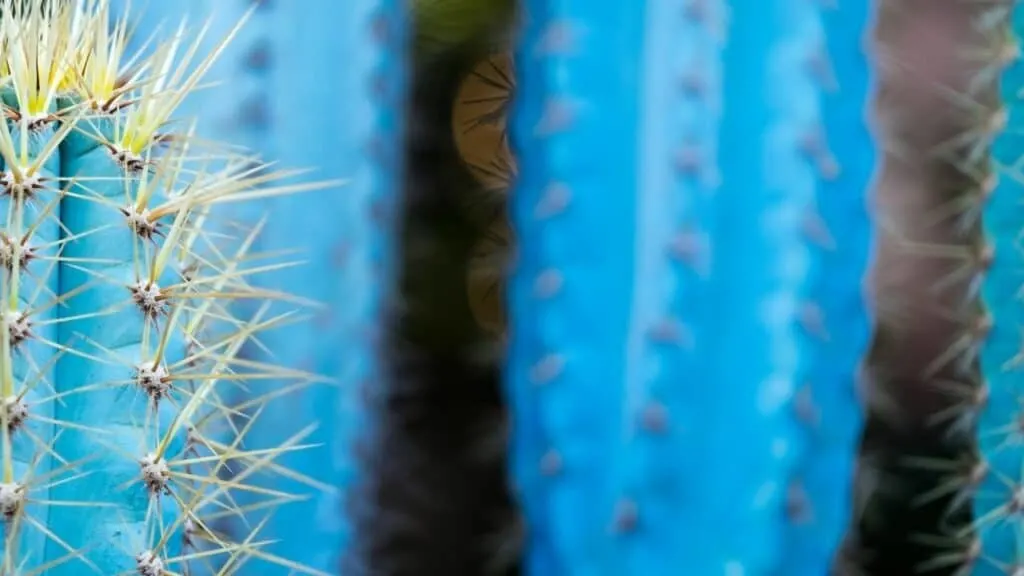
Pilosocereus azureus, or The Blue Torch Cactus is a magnificent silvery-blue tree-like pillar cactus with long, bright yellow spines. The blue color gets darker and even more stunning as this succulent mature.
This cactus, native to Brazil, branches just like a tree. It is a fast grower and can reach 33 feet.
If you keep your Blue Torch at home, do not worry, you will not wake up to a giant monster in your room. It will stay room-size for a few years before you have to move it to the garden and replace it with its babies.
Pilosocereus azureus is easy to grow and is low-maintenance. It needs full sun, a hot and dry environment, and occasional watering.
Plant it in the well-draining succulent or cactus soil mix and water only when completely dry. Water it thoroughly and make sure that the excess water drains well.
Blue Torch cactus blooms at night, producing beautiful, large white flowers and fruit. Harvest seeds from the fruits to propagate your cactus.
If you want to know more about the Blue Torch cactus, read our in-depth Pilosocereus azureus care guide!

Daniel has been a plant enthusiast for over 20 years. He owns hundreds of houseplants and prepares for the chili growing seasons yearly with great anticipation. His favorite plants are plant species in the Araceae family, such as Monstera, Philodendron, and Anthurium. He also loves gardening and is growing hot peppers, tomatoes, and many more vegetables.

